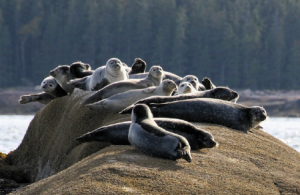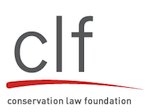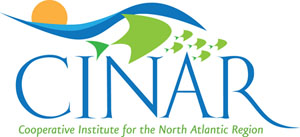Looking back on 20 years of progress
Located in a neat white house on Blue Hill’s picturesque Main Street, the Marine Environmental Research Institute (MERI) is marking its twentieth anniversary this year.
A roster of international scientists, naturalists and adventurers will be featured by the Institute throughout the year as part of its Ocean Environment Lecture series. In addition, conservation advocate Jim Fowler will be the keynote speaker at the Institute‘s anniversary gala on July 2.
It all started with seals. Here a group of seals suns themselves on a rock.
MERI began its life as an independent scientific research organization in a small office in Brooklin, Maine in 1990 under the guidance of Dr. Susan Shaw.
“I was a graduate student at Columbia University in environmental toxicology and public health [in the mid-80s],” recalled Shaw, 66. “There was a huge die-off of harbor seals in Europe in 1988 — more than 20,000 seals died that year. They found high levels of PCBs but couldn’t prove that the deaths were pollution related.”
Shaw was horrified and intrigued by the images she saw. What would cause these mammals, so high on the marine food chain, to die in such high numbers?
Shaw set up a long-term scientific study of two species of Pacific seals in concert with nine different scientific institutions and laboratories across the country to investigate the question. “The project became my Ph.D. thesis,” Shaw said. She was living at the time in Maine and, as the study progressed, established MERI with several international scientists to focus attention on the results.
“I always though that it [MERI] would work because these studies were needed,” Shaw said, referring to the institute’s ongoing research on the effects of persistent pollutants in the marine environment. When Shaw’s study of Pacific seals concluded in 1999, MERI turned its attentions to the seals of the Northwest Atlantic, specifically the Gulf of Maine.
A seal adorns the MERI sign on the building on Main St. in Blue Hill, Maine.
The Seals as Sentinels program, begun in 2000, documents the effects of hundreds of man-made chemicals in marine mammals along the Atlantic coasts.
“We set up a field station [in the Blue Hill headquarters] to work with the Northeast Marine Mammal Stranding Network. With the surgical lab, we are able to take in stranded or dead animals and do surgery or necropsies,” Shaw said. The animals were tested for a selection of persistent organic chemicals. MERI currently houses the largest tissue bank from marine mammals in the northeast.
Drawing on the data gained during the decade-long study of seal populations, Shaw found that Gulf of Maine harbor seals are highly contaminated by persistent organic pollutants and toxic metals such as mercury. In addition, animals tested by MERI show high levels of chemicals used in common consumer products, such as brominated flame retardants. These contaminants tend to bioaccumulate and thus are found at high levels in top predators such as seals.
“We’ve expanded that program to include seven species of commercially valuable fish from the Gulf of Maine,” Shaw explained. Through sampling fish species, MERI researchers hope to determine how the persistent organic chemicals are accumulating in seals and other marine mammals.
“Think of it this way: seals are an important indicator species at the top of the marine food web, thus they are comparable to humans. We are drilling down into the food web to look at their diet,” Shaw explained. “Many of the species they eat, we eat.”
MERI was recognized for its pioneering work on chemicals in the marine environment in 2007 by the Maine State Legislature. Shaw was named a Gulf of Maine Visionary Award winner by the Gulf of Maine Council on the Marine Environment that same year. She is also a Fellow of the Explorers Club in New York City where she co-founded the State of the Ocean Forum with oceanographer Sylvia Earle (see book review).
“I’m very proud of what we’ve accomplished [in 20 years],” Shaw said. After moving to its new headquarters in 2000, MERI expanded its activities. The building houses marine research laboratories, public lecture and conference space, the McCrum Sea Lending Library and a small ocean aquarium replicating the Gulf of Maine ecosystem.
The Ocean Environment Lecture series brings world-renowned researchers to the small town to speak throughout the year. The Elisabeth Mann Borgese Lecture series, begun in in 2002 in memory of the late MERI board member and Dalhousie University professor, features experts on marine pollution, fisheries management, seafood safety, endangered species and ocean conservation
July’s anniversary speaker, Fowler, is well known as host of the long-running television show “Mutual of Omaha’s Wild Kingdom.” He is also an advocate for wildlife conservation around the world, serving as president of the Fowler Center for Wildlife Education in New York and as the honorary president of the Explorers Club.
Dr. Susan Shaw, founder and director of MERI.
“It’s almost shocking to me, looking back to see where we are now. We now have a large body of data about this ecosystem [the Gulf of Maine] and can provide that data to policy makers. They in turn use it to craft legislation to protect us from the effects of these chemicals that are legal but harmful,” Shaw said.
For a full list of events at MERI, visit the web site http://www.meriresearch.org.
******
Susan Shaw credits the following people with helping MERI succeed over the past 20 years:
Sally Chadbourne, Associate Director 2003 – 2010, instrumental in getting NOAA funding for MERI’s Seals As Sentinels research, involved in strategic planning, all operations
Terry & Amy Britton – helped establish the marine laboratories & research programs at the MERI Center for Marine Studies, Amy is a MERI board member
Greg Sundberg – MERI Board of Directors (Treasurer), heads Sundberg Associates, a design/branding firm in NYC, handles all print and digital media, designed the MERI website
Cynthia Stroud – founding board member (1990-91), helped establish the MERI Center for Marine Studies in 2000
Dr. Lemuel Evans – Chairman of the MERI Board of Directors 1994-2002, involved with strategic planning, expanding the research, establishing the MERI Center in Blue Hill
Breene and Shery Kerr – became involved with MERI’s first Capital Campaign “Science and the Sea” (2002-2006), major supporters of research & monitoring
Nova Scotian Peter Wells, who brought me into the GOM Council (2002) and has supported our Seals As Sentinels research.
Print





















